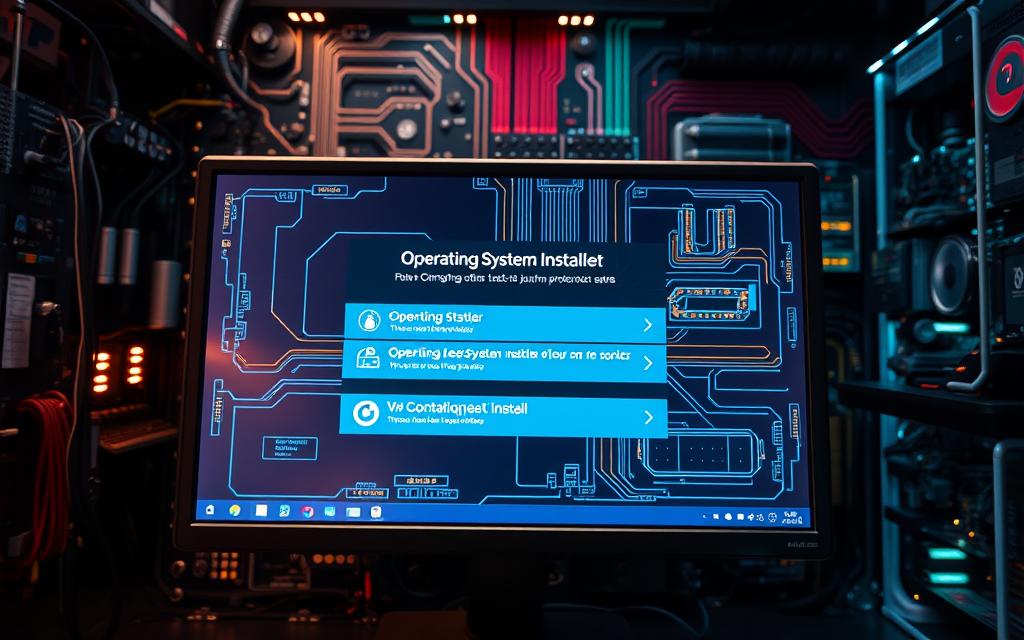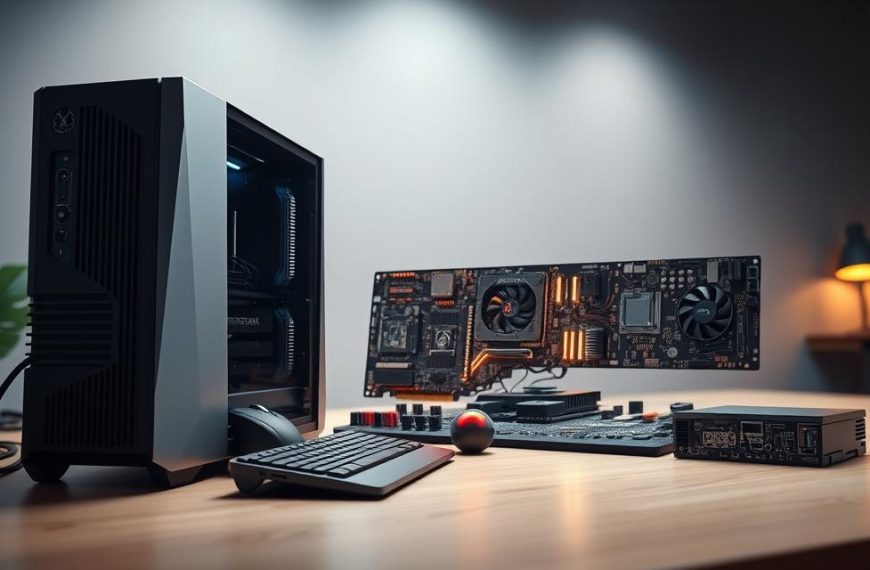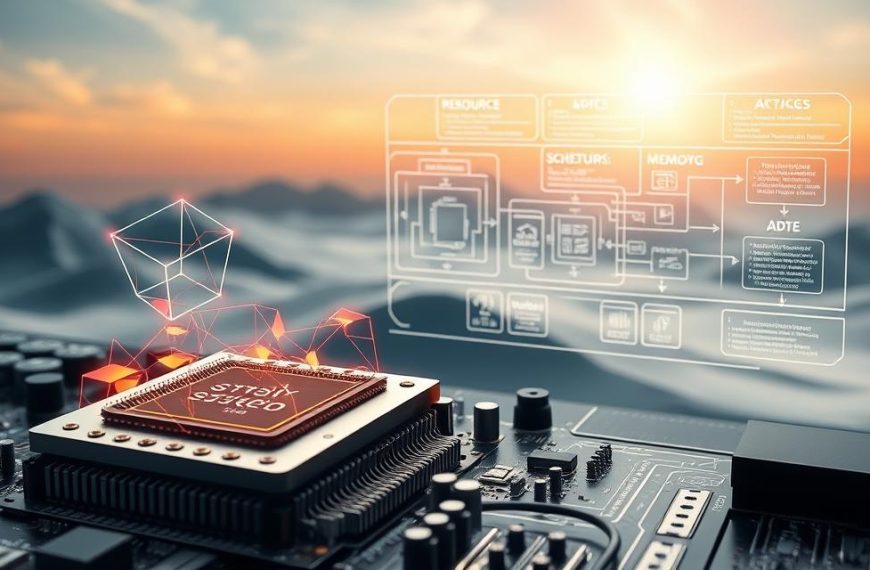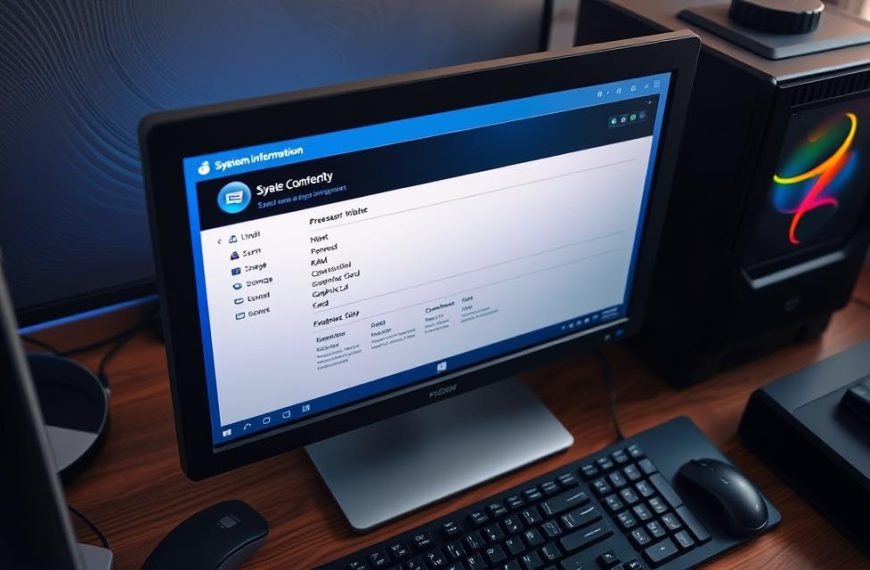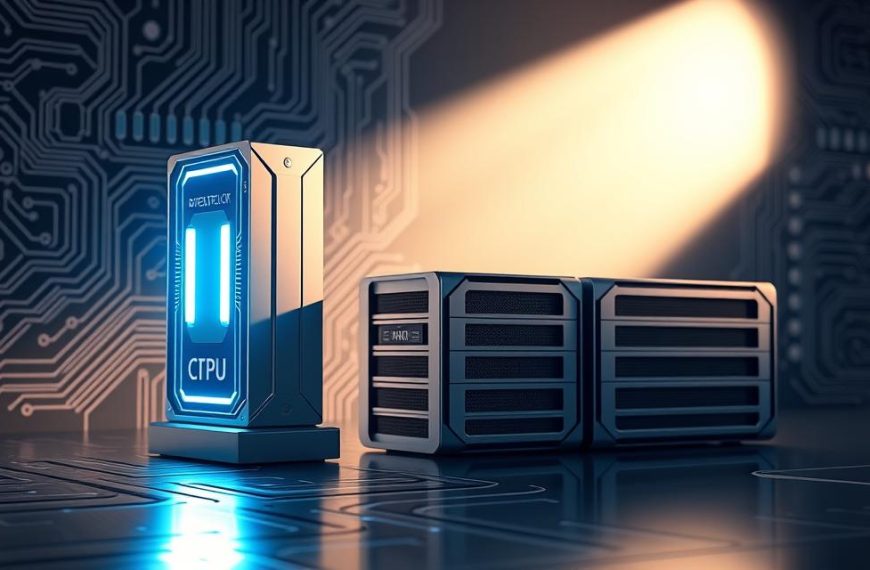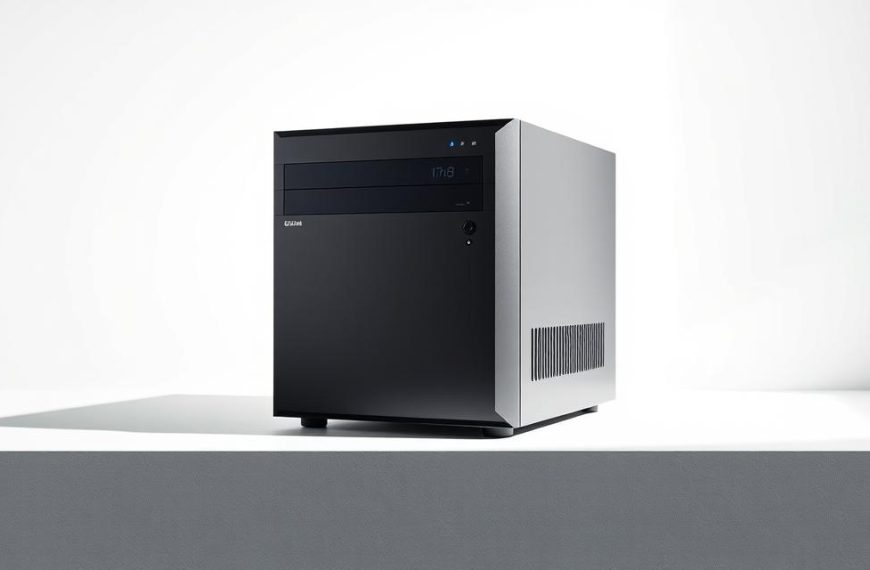Starting your first operating system installation might look tough, but it’s doable. This guide breaks it down into easy steps.
Setting up your computer OS correctly is key to your device’s performance and safety. Doing it right from the start avoids many problems later.
Our beginner OS guide covers everything from getting ready to the final setup. You’ll discover important checks before starting and what to look out for during the process.
Whether you’re upgrading or starting from scratch, this detailed method will help you succeed. Stick with it to feel more confident in managing your computer’s core software.
Essential Preparations Before Installation
Starting a new operating system involves more than just creating the installation media. You need to make key decisions and check a few things first. These steps are vital for a smooth installation and help avoid problems that could damage your data or system.
Choosing the Right Operating System
Choosing your OS starts with knowing what you need and what your computer can handle. Different systems suit different users:
- Windows is great for gaming, office work, and multimedia
- Linux distributions are perfect for developers and those who value privacy
- macOS is best for creative professionals, but you need specific hardware
Think about what you do most on your computer. This will help you pick the right OS. Look into each system’s apps and support before deciding.
System Requirements and Compatibility Checks
After picking your OS, check if your computer meets the system compatibility requirements. Each OS has specific hardware needs for it to work well.
Important things to check include:
- Processor speed and type (32-bit vs 64-bit)
- RAM and its type
- How much storage you need
- Graphics card quality
- If your devices work with the new OS
Not checking system compatibility can lead to problems. Make sure your computer meets the OS’s requirements. Check the official documentation for details.
Backing Up Your Important Data
Backing up your data is the most important step. Installing a new OS can sometimes go wrong, leading to data loss if you’re not careful.
Use these methods for data backup:
- External hard drives or USB drives
- Cloud services like Google Drive or Dropbox
- Network-attached storage (NAS) systems
- Disk imaging software for full system backups
Make sure your backups are complete and you can access them before installing. This data backup keeps your files, settings, and documents safe during the installation.
By carefully choosing your OS, checking compatibility, and backing up your data, you set yourself up for a successful installation. These steps help avoid risks and make the transition to a new system smoother.
Creating Bootable Installation Media
First, pick your operating system and get ready. Then, make bootable installation media. This turns a regular USB drive or disc into a tool for installing your computer’s OS. Today, USB drives are more common than discs.
Downloading the OS Installation Files
Start by getting the official installation files. For Windows, use Microsoft’s Media Creation Tool. Linux users can find ISO files on their official websites. Make sure the files are real and right for your system.
It’s important to download the right version for your computer. Files can be big, up to 5 GB. So, a good internet connection is needed. Save the files somewhere easy to find before you go on.
Using USB Drives vs Optical Discs
Think about the differences between USB drives and discs:
- USB drives are faster and more convenient
- Most computers today don’t have discs, so USB is better
- You can use a USB drive many times
- Discs are good for keeping things for a long time
USB drives make installing an OS much quicker. A USB 3.0 drive can do it in 15-20 minutes. Discs might take 45 minutes or more.
Tools for Creating Bootable Media: Rufus and UNetbootin
There are special tools to make bootable media. Rufus tool is great for Windows. It’s simple and works well.
UNetbootin is good for Linux users. It works on many platforms and is easy to use. Both tools help you make your media with clear steps.
Here’s how to make bootable media:
- Put in your USB drive (at least 8GB)
- Open your chosen tool (Rufus or UNetbootin)
- Pick the ISO file you downloaded
- Choose your USB drive from the list
- Begin the process and wait for it to finish
After it’s done, safely remove your USB. This prevents any problems before you start installing.
Configuring Your Computer’s BIOS/UEFI Settings
To install a new operating system, your computer must recognise and boot from the installation media. You need to access and modify your computer’s firmware settings. These settings control how your hardware behaves before any operating system loads.
Accessing BIOS/UEFI on Different Computer Brands
Getting into your computer’s firmware settings varies by brand. Most systems need you to press a specific key during the initial boot sequence. This is usually when the manufacturer’s logo appears.
The timing is key – you have just a few seconds to press the right key.
Common access keys include:
- DEL or Delete: Used by many desktop motherboards
- F2: Common on Dell, Acer, and some HP systems
- F10: Frequently used by HP and Compaq computers
- F12: Often provides boot menu options on Lenovo and Dell systems
- ESC: Used by some Toshiba and other brands
If you’re unsure which key to press, check your computer’s manual or search online for your model. Newer computers with UEFI firmware might have faster boot times. This makes accessing these settings harder. You might need to use Windows’ advanced startup options to access UEFI settings.
Changing Boot Order and Secure Boot Settings
Inside your firmware settings, find the boot options. The term might vary, but look for “Boot Order,” “Boot Priority,” or similar. This setting decides which device your computer tries to boot from first.
For installation, set your USB drive or DVD drive as the first boot device. This ensures your computer boots from your installation media, not your hard drive’s existing OS.
Secure Boot is another important setting. It’s a UEFI security feature that prevents unauthorised operating systems from loading. While it’s good for security, it can sometimes block certain operating system installations. You might need to disable Secure Boot during installation, but many modern operating systems support it.
For more on these settings, this guide to BIOS basics is very helpful.
| Setting Category | Common Options | Recommended Configuration | Purpose |
|---|---|---|---|
| Boot Priority | Hard Drive, USB, CD/DVD, Network | USB or DVD first during installation | Controls boot device sequence |
| Secure Boot | Enabled/Disabled | Disabled if OS doesn’t support it | Prevents unauthorised OS loading |
| SATA Operation | AHCI, RAID, IDE | AHCI for modern systems | Controls hard drive communication |
| Fast Boot | Enabled/Disabled | Disabled during installation | Speeds up boot but may skip devices |
After changing your BIOS or UEFI settings, save your changes before exiting. Most systems use F10 to save and exit. Check the on-screen prompts for confirmation. Your computer will then restart with the new settings, ready for the operating system installation.
Step-by-Step: How to Put an Operating System on a Computer
Now that your system is set up, it’s time to start the OS installation steps. This will turn your computer into a working machine. Follow these steps carefully for a smooth setup.
Starting the Installation Process
Put in your bootable media and restart your computer. You’ll see a prompt to press any key to boot from the installation device. Act fast, as this message goes away quickly.
The installer will load files, which might take a few minutes. You’ll then see the initial setup screen for your chosen operating system. Choose your language, time format, and keyboard layout before moving on.
Click the “Install Now” button. The system will show you the license terms. Read these carefully before agreeing to continue with the OS installation steps.
Partitioning Your Hard Drive
This important step prepares storage space for your operating system. You’ll see a list of available drives and partitions. For a new computer, the drive will show as unallocated space.
Click “New” to create partitions. The system will ask for the partition size. Most users choose to use the whole drive for the OS partition. The installer will create necessary system partitions automatically.
If you’re reinstalling an OS, you might see existing partitions. You can format or delete these to start over. Warning: Formatting or deleting partitions will erase all data on them.
Proper hard drive partitioning ensures your system works well and is organised. For detailed guidance, check this installation walkthrough.
Completing the Installation and First Boot
After partitioning, the system starts copying files. This can take 20-40 minutes, depending on your hardware. Your computer may restart a few times during this phase.
Once file copying is done, you’ll reach the final setup stage. Here, you’ll create your user account, set a password, and configure privacy settings. Choose a strong password to keep your system safe.
The setup will then apply your preferences and prepare your desktop. When it’s all done, you’ll see your system’s first boot into the new operating system.
During this first boot, the system may install extra drivers or updates. Be patient and don’t interrupt this process. Soon, you’ll see your fresh desktop environment, ready for use.
Congratulations! You’ve successfully completed the OS installation steps and can now start using your newly configured computer.
Troubleshooting Common Installation Issues
Even with careful preparation, operating system installations can sometimes encounter unexpected hurdles. Recognising and resolving these challenges promptly ensures a smooth computing experience from the very first boot.
Driver Compatibility Problems
Driver issues frequently emerge after a fresh OS installation. These software components enable hardware communication, and missing or outdated versions can cause significant functionality gaps.
Network adapters often present the most immediate challenge. Without proper drivers, internet access becomes impossible, creating a frustrating catch-22 situation. The solution lies in preparatory measures taken before installation begins.
Always download the latest drivers from your hardware manufacturer’s website beforehand. Store them on external media or a separate partition. Manufacturer-provided CDs or DVDs also contain essential drivers, though these may be outdated.
For situations where internet access is unavailable, Windows includes basic generic drivers that provide minimal functionality. These allow temporary connectivity to download proper drivers from manufacturer websites.
Bootloader Errors and Solutions
Bootloader errors prevent your system from starting properly, often displaying intimidating messages that halt the boot process. These issues typically arise from incorrect installation sequences or hardware conflicts.
Common error messages include “Bootmgr is missing” or “Operating system not found.” These indicate the bootloader cannot locate or load the operating system files properly.
Most modern operating systems include built-in repair tools that can automatically fix bootloader problems. Windows Installation Media provides access to Startup Repair, while Linux distributions offer recovery modes and GRUB repair utilities.
For persistent issues, bootloader reconfiguration may be necessary. Tools like EasyBCD for Windows or Boot-Repair for Linux can reconstruct damaged boot configurations. In extreme cases, a complete reinstallation from scratch becomes the final solution.
Always ensure Secure Boot settings in your UEFI/BIOS align with your operating system’s requirements. Mismatched settings frequently cause bootloader failures that simple software fixes cannot resolve.
Conclusion
This guide has given you a detailed look at installing an OS. It covers everything from getting ready to setting it all up. It’s important to plan well, make the right boot media, and set up your BIOS/UEFI correctly.
Once it’s installed, there are steps to take to make it work better. Update your drivers, like for graphics and network. Also, run system updates to keep your computer safe and fast.
Now you can enjoy your new operating system. A successful install means you’re ready for a great computing experience. Keep learning and tweaking to get the most out of your device.

